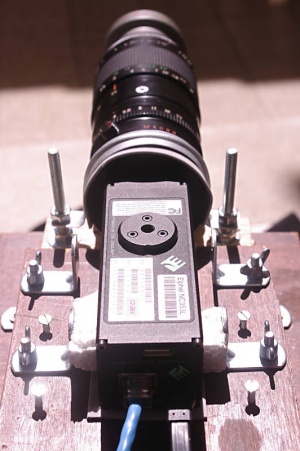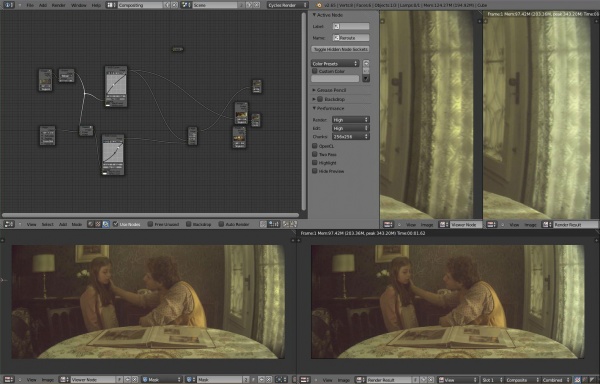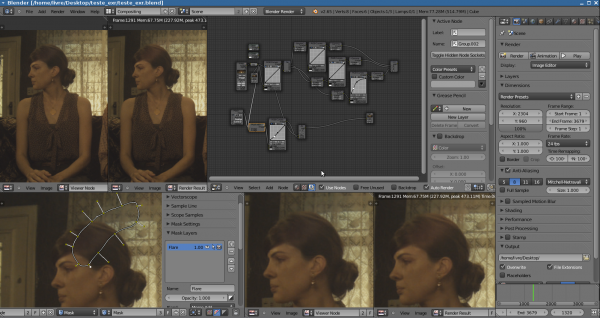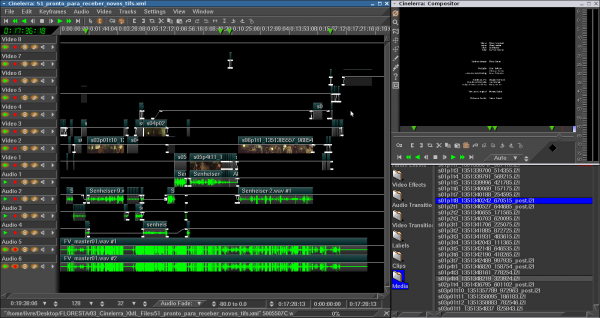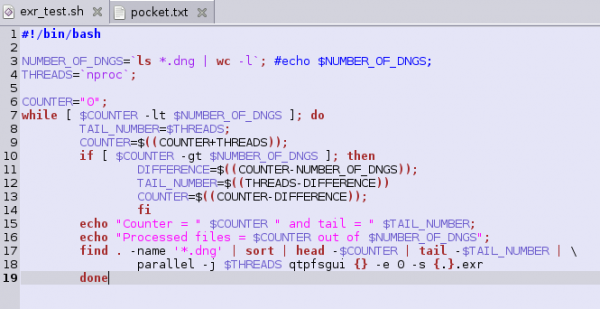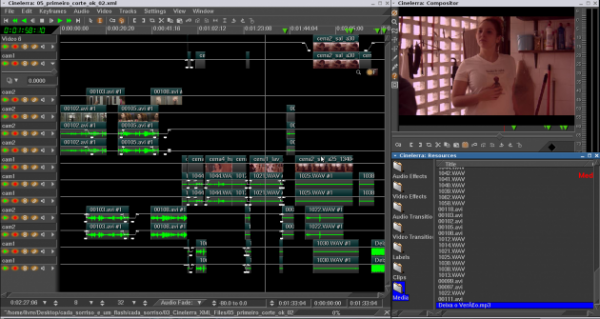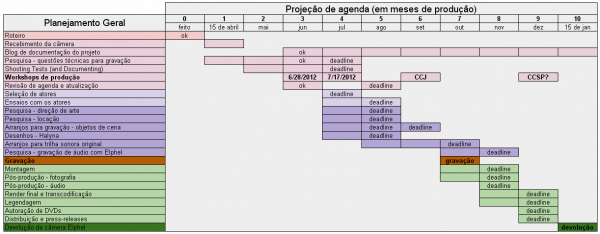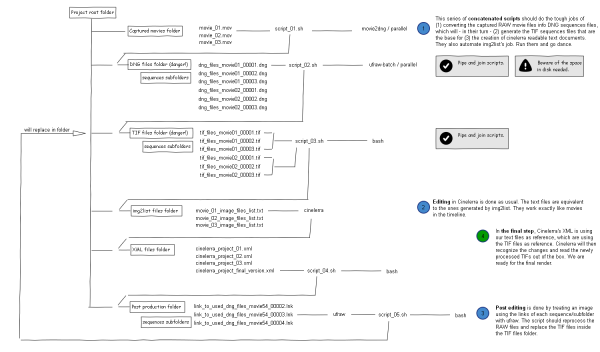Difference between revisions of "FlorestaVermelha"
(Major update on project's status) |
(Update as of March 1st) |
||
| Line 7: | Line 7: | ||
<br> | <br> | ||
| − | == Current status of the project == | + | == Current status of the project - nearly finished == |
| − | + | The movie was shot on the months of October/November, 2012. It was then edited and exhibited for ~150 people during a party on November the 30th, in which the band that created the soundtrack performed the music live. Since then, we have been focused on finishing the soundtrack and the audio (done by January, 2013) and are currently finishing the color grading.Last update on the project status (this section): March the 1st, 2013. | |
| + | <br> [[Image:Lens adapter 3.jpg|thumb|center|300px|Lens adapter 3.jpg]] | ||
| − | [[ | + | <br> |
| + | |||
| + | === '''Videos'''<br> === | ||
| + | |||
| + | Watch the videos we have made: there are the [http://florestavermelha.org/2012/12/13/floresta-vermelha-red-forest-teasers/ teasers to the movie] (version in English and Portuguese), there is the [http://florestavermelha.org/2013/02/21/floresta-vermelha-no-metropolis-tv-cultura/ interview we have given for a Brazilian TV channel] (Portuguese only), and a [http://florestavermelha.org/2012/09/06/cce_sp-o-video-cce_sp-the-video-with-english-subtitles/ video explaining our project as a whole] (English and Portuguese). In the [http://florestavermelha.org/tag/galeria-de-videos/ video gallery], you can also check a [http://florestavermelha.org/2012/08/27/minicurta-cada-sorriso-e-um-flash/ mini-short movie] we made as a test for the use of the camera in the field and[http://florestavermelha.org/2012/08/17/gravacoes-de-teste-os-videos/ two videos that explain how the recording in RAW mode is made].<br> | ||
| + | |||
| + | <br> | ||
| + | |||
| + | === Return to community<br> === | ||
| + | As a project, we focused on three main returns for the community: recording audio with the camera, creating and documenting on the workflow for video editing (RAW format) in Linux and on creating automation scripts for this workflow. These steps are all covered in details in two major articles, [[G https://szaszak.wordpress.com/linux/elphel-as-a-digital-cinema-camera/|A somewhat comprehensible guide to using Elphel as a Digital Cinema camera]] (in English) and [https://szaszak.wordpress.com/linux/digital_cinema_automation/ digital cinema workflow under linux – automation] (in English). We also wrote an [https://szaszak.wordpress.com/metalab-floresta-vermelha/ introductory article in Portuguese] explaining the project in this language.<br> | ||
| − | + | <br> The automation scripts are all GPL-licensed and have been forwarded to Elphel's support list, but they will soon be published apropriately on a recently-created account at GitHub. | |
| − | + | <br> | |
| − | + | === News === | |
| − | [[ | + | The most up-to-date news, news on the production of the film and on this research can be found at the posts in our blog (in Portuguese): [http://florestavermelha.org/ florestavermelha.org]. You can also check the technical stuff at [http://szaszak.wordpress.com/linux/ our other blog]. |
| − | + | <br> | |
| − | + | === Images from the production === | |
| + | [[Image:Cortinas revisadas.jpg|thumb|center|600px|Cortinas revisadas.jpg]]<br> [[Image:Reduzindo flare.png|thumb|center|600px|Reduzindo flare.png]]<br> [[Image:Creditos prontos.png|thumb|center|600px]<br> [[Image:Projeto cinelerra1.png|thumb|center|600px|Projeto cinelerra1.png]]<br> [[Image:Pocket script for george lucas.png|thumb|center|600px|Pocket script for george lucas.png]]<br> | ||
| − | == | + | === '''Workshops''' === |
| − | + | To be able to shoot our movie in an open way, we ran a couple of workshops, in which we introduce the Elphel camera and the whole editing workflow for it in Linux. You can see some pictures of the first one [https://secure.flickr.com/photos/ccesaopaulo/archives/date-posted/2012/07/12/?view=md here] and in a blog post [http://florestavermelha.org/2012/06/29/obrigado/ here]. These workshops included a mini short movie (2 1/2 min), to test how to use Elphel for recording in the field, in conditions similar to those we will have in our production. The picture below shows Cinelerra's editing project, before going to post-production: | |
| − | [[ | + | [[Image:Minicurta.png|thumb|center|600px|Minicurta.png]] |
| + | <br> | ||
<br> | <br> | ||
| − | You should notice that there is a somewhat large period before the actual shooting takes place. This period is dedicated to research and documentation on the process, especially about everything that relates to the use of the camera for the shooting. <br> | + | == General planning == |
| + | |||
| + | A somewhat updated schedule for our project can be seen below:<br> | ||
| + | |||
| + | [[Image:Schedule update floresta vermelha.PNG|thumb|center|600px|Schedule update floresta vermelha.PNG]]<br> | ||
| + | |||
| + | <br> <br> | ||
| + | |||
| + | You should notice that there is a somewhat large period before the actual shooting takes place. This period is dedicated to research and documentation on the process, especially about everything that relates to the use of the camera for the shooting. <br> | ||
| − | <br> | + | <br> |
== Return to community<br> == | == Return to community<br> == | ||
| Line 63: | Line 83: | ||
The last item (3) is exemplified by this workflow:<br> | The last item (3) is exemplified by this workflow:<br> | ||
| − | [[ | + | [[Image:Image workflow research guide v2.png|thumb|center|600px|Image workflow research guide v2.png]]<br> |
The results of the research will be published as articles under a GNU Free Documentation License and following the formats of the previous articles. | The results of the research will be published as articles under a GNU Free Documentation License and following the formats of the previous articles. | ||
| − | The scripts resulting from the 3rd item above will also be published under a GPL license and be freely available for the community. | + | The scripts resulting from the 3rd item above will also be published under a GPL license and be freely available for the community. |
| − | == Shooting and editing (free software) == | + | == Shooting and editing (free software) == |
It must be pondered that how we are going to shoot depends on the results we may or may not have achieved on financing the movie. Basically, we should consider something between all-voluntary work and a complete professional environment, with everyone getting paid and with more time to dedicate to the movie. We have to be prepared to both scenarios. | It must be pondered that how we are going to shoot depends on the results we may or may not have achieved on financing the movie. Basically, we should consider something between all-voluntary work and a complete professional environment, with everyone getting paid and with more time to dedicate to the movie. We have to be prepared to both scenarios. | ||
Revision as of 11:31, 1 March 2013
Contents
[hide]Project name: Floresta Vermelha (Red Forest)
Objectives
The Red Forest project aims at shooting a short film using original soundtrack and original screenplay. The intention is to shoot using the standards of digital cinema of at least 2k resolution (but hopefully CIMAX) and RAW recording. To get there, we aim to shoot it with Elphel, use only free software and document on the process.
Current status of the project - nearly finished
The movie was shot on the months of October/November, 2012. It was then edited and exhibited for ~150 people during a party on November the 30th, in which the band that created the soundtrack performed the music live. Since then, we have been focused on finishing the soundtrack and the audio (done by January, 2013) and are currently finishing the color grading.Last update on the project status (this section): March the 1st, 2013.
Videos
Watch the videos we have made: there are the teasers to the movie (version in English and Portuguese), there is the interview we have given for a Brazilian TV channel (Portuguese only), and a video explaining our project as a whole (English and Portuguese). In the video gallery, you can also check a mini-short movie we made as a test for the use of the camera in the field andtwo videos that explain how the recording in RAW mode is made.
Return to community
As a project, we focused on three main returns for the community: recording audio with the camera, creating and documenting on the workflow for video editing (RAW format) in Linux and on creating automation scripts for this workflow. These steps are all covered in details in two major articles, A somewhat comprehensible guide to using Elphel as a Digital Cinema camera (in English) and digital cinema workflow under linux – automation (in English). We also wrote an introductory article in Portuguese explaining the project in this language.
The automation scripts are all GPL-licensed and have been forwarded to Elphel's support list, but they will soon be published apropriately on a recently-created account at GitHub.
News
The most up-to-date news, news on the production of the film and on this research can be found at the posts in our blog (in Portuguese): florestavermelha.org. You can also check the technical stuff at our other blog.
Images from the production
[[Image:Creditos prontos.png|thumb|center|600px]
Workshops
To be able to shoot our movie in an open way, we ran a couple of workshops, in which we introduce the Elphel camera and the whole editing workflow for it in Linux. You can see some pictures of the first one here and in a blog post here. These workshops included a mini short movie (2 1/2 min), to test how to use Elphel for recording in the field, in conditions similar to those we will have in our production. The picture below shows Cinelerra's editing project, before going to post-production:
General planning
A somewhat updated schedule for our project can be seen below:
You should notice that there is a somewhat large period before the actual shooting takes place. This period is dedicated to research and documentation on the process, especially about everything that relates to the use of the camera for the shooting.
Return to community
The research should focus on the incertain terrains of:
1. How to record sound with the camera or using external devices;
2. Establish the editing workflow in linux and the image post-production workflow in linux. This project considers working only with free software. This step is the continuation of the research presented here and here;
3. Automate via scripts the steps of:
- (a) files convertion prior to editing (piped scripting);
- (b) creation of a human-readable list of files for post-production from Cinelerra's editing XML file; and
- (c) replacement of final TIF files in theis original folders for final render.
The last item (3) is exemplified by this workflow:
The results of the research will be published as articles under a GNU Free Documentation License and following the formats of the previous articles.
The scripts resulting from the 3rd item above will also be published under a GPL license and be freely available for the community.
Shooting and editing (free software)
It must be pondered that how we are going to shoot depends on the results we may or may not have achieved on financing the movie. Basically, we should consider something between all-voluntary work and a complete professional environment, with everyone getting paid and with more time to dedicate to the movie. We have to be prepared to both scenarios.
Editing, post editing and everything else that relates to the movie (except, possibly already recorded soundtrack) will be done using free software.
Workshops
To help drawing attention to the project, spreading the word and help making contacts, we consider running some production workshops to talk about the movie and the production process to anyone who might be interested, but with especial attention to the linux community. Those workshops will be technical-based and, without being too optimistic, there is good chance of finding partners to them.
About the movie and the screenplay
The movie will be Portuguese-spoken. The screenplay, written in Celtix (GPL), focus on inside environments so that we have better control over scenario and shooting situations. Since the script is simple, we may consider asking someone to write an alternative screenplay while at research phase, but it must be noted that the existent one was written simple due to the nature of the project. It would be dramatic to discover we would have to shoot a scene without means of doing so.
Once finished, the movie will be available online. It must be said that all the documentation for the project will be under open licenses as stated in the agreement. The movie, however, is bound to a complex mixture of copyrights and will probably be released under a Creative Commons license. If everything goes fine, we should be able to write some press releases and distribute a few copies of the final version to the media in DVD format.
